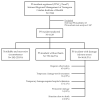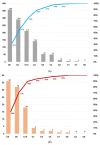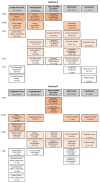Analysis of Patient Safety Incidents in Primary Care Reported in an Electronic Registry Application
- PMID: 34501530
- PMCID: PMC8430626
- DOI: 10.3390/ijerph18178941
Analysis of Patient Safety Incidents in Primary Care Reported in an Electronic Registry Application
Abstract
Objectives: (1) To describe the epidemiology of patient safety (PS) incidents registered in an electronic notification system in primary care (PC) health centres; (2) to define a risk map; and (3) to identify the critical areas where intervention is needed.
Design: Descriptive analytical study of incidents reported from 1 January to 31 December 2018, on the TPSC Cloud™ platform (The Patient Safety Company) accessible from the corporate website (Intranet) of the regional public health service.
Setting: 24 Catalan Institute of Health PC health centres of the Tarragona region (Spain).
Participants: Professionals from the PC health centres and a Patient Safety Functional Unit.
Measurements: Data obtained from records voluntarily submitted to an electronic, standardised and anonymised form. Data recorded: healthcare unit, notifier, type of incident, risk matrix, causal and contributing factors, preventability, level of resolution and improvement actions.
Results: A total of 1544 reports were reviewed and 1129 PS incidents were analysed: 25.0% of incidents did not reach the patient; 66.5% reached the patient without causing harm, and 8.5% caused adverse events. Nurses provided half of the reports (48.5%), while doctors reported more adverse events (70.8%; p < 0.01). Of the 96 adverse events, 46.9% only required observation, 34.4% caused temporary damage that required treatment, 13.5% required (or prolonged) hospitalization, and 5.2% caused severe permanent damage and/or a situation close to death. Notably, 99.2% were considered preventable. The main critical areas were: communication (27.8%), clinical-administrative management (25.1%), care delivery (23.5%) and medicines (18.4%); few incidents were related to diagnosis (3.6%).
Conclusions: PS incident notification applications are adequate for reporting incidents and adverse events associated with healthcare. Approximately 75% and 10% of incidents reach the patient and cause some damage, respectively, and most cases are considered preventable. Adequate and strengthened risk management of critical areas is required to improve PS.
Keywords: incident notification; patient safety; primary care; risk management.
Conflict of interest statement
The authors declare no conflict of interest.
Figures




Similar articles
-
[Patient safety incidents reported before and after the start of the COVID-19 pandemic in Primary Care in Tarragona].Aten Primaria. 2021 Dec;53 Suppl 1(Suppl 1):102217. doi: 10.1016/j.aprim.2021.102217. Aten Primaria. 2021. PMID: 34961580 Free PMC article. Spanish.
-
[Notification of incidents related to patient safety in hospitals in Catalonia, Spain during the period 2010-2013].Med Clin (Barc). 2014 Jul;143 Suppl 1:55-61. doi: 10.1016/j.medcli.2014.07.012. Med Clin (Barc). 2014. PMID: 25128361 Spanish.
-
Can Patient Safety Incident Reports Be Used to Compare Hospital Safety? Results from a Quantitative Analysis of the English National Reporting and Learning System Data.PLoS One. 2015 Dec 9;10(12):e0144107. doi: 10.1371/journal.pone.0144107. eCollection 2015. PLoS One. 2015. PMID: 26650823 Free PMC article.
-
Harms from discharge to primary care: mixed methods analysis of incident reports.Br J Gen Pract. 2015 Dec;65(641):e829-37. doi: 10.3399/bjgp15X687877. Br J Gen Pract. 2015. PMID: 26622036 Free PMC article. Review.
-
An International Perspective on Definitions and Terminology Used to Describe Serious Reportable Patient Safety Incidents: A Systematic Review.J Patient Saf. 2021 Dec 1;17(8):e1247-e1254. doi: 10.1097/PTS.0000000000000700. J Patient Saf. 2021. PMID: 32271529 Free PMC article.
Cited by
-
Characterization of Safety Events Involving Technology in Primary and Community Care.Appl Clin Inform. 2023 Oct;14(5):1008-1017. doi: 10.1055/s-0043-1777454. Epub 2023 Dec 27. Appl Clin Inform. 2023. PMID: 38151041 Free PMC article.
-
How does communication affect patient safety? Protocol for a systematic review and logic model.BMJ Open. 2024 May 27;14(5):e085312. doi: 10.1136/bmjopen-2024-085312. BMJ Open. 2024. PMID: 38802275 Free PMC article.
-
Patient Safety Incidents in Primary Care: Comparing APEAS-2007 (Spanish Patient Safety Adverse Events Study in Primary Care) with Data from a Health Area in Catalonia (Spain) in 2019.Healthcare (Basel). 2024 May 25;12(11):1086. doi: 10.3390/healthcare12111086. Healthcare (Basel). 2024. PMID: 38891161 Free PMC article.
-
Professional burnout and patient safety culture in Primary Health Care.Rev Bras Enferm. 2023 Aug 7;76(3):e20220311. doi: 10.1590/0034-7167-2022-0311. eCollection 2023. Rev Bras Enferm. 2023. PMID: 37556689 Free PMC article.
-
Is primary care a patient-safe setting? Prevalence, severity, nature, and causes of adverse events: numerous and mostly avoidable.Int J Qual Health Care. 2023 Apr 29;35(2):mzad019. doi: 10.1093/intqhc/mzad019. Int J Qual Health Care. 2023. PMID: 37043330 Free PMC article.
References
-
- World Health Organisation . World Alliance for Patient Safety. The Launch of the World Alliance for Patient Safety; Washington, DC, USA: Oct 27, 2004. [(accessed on 1 July 2021)]. Available online: https://www.who.int/patientsafety/worldalliance/en/
-
- Iglesia M., Margetidis G., Montante S., Azzolini E., Ricciardi W. Moving a step forward to promote patient safety and quality of care in Europe. Epidemiol. Biostat. Public Health. 2014;11:e11034. doi: 10.2427/11034. - DOI
Publication types
MeSH terms
LinkOut - more resources
Full Text Sources
Medical

